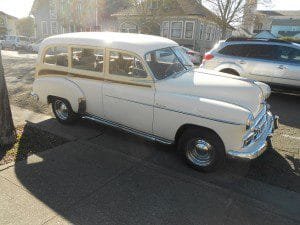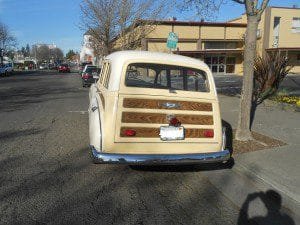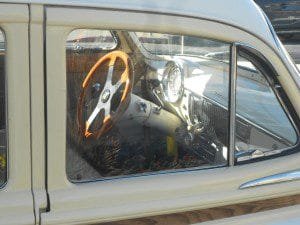Chevrolet had been producing woody wagons since 1939. The wood coach building had been farmed out to companies such as Hercules, Cantrell and Ionia. There was a difference as to the wood used by the various coach builders.

Hercules built the wood paneling from mahogany and framed it in ash. Both Ionia and Cantrell paneled the wagons in birch. Coach builders actually made an entire industry of producing wood coaches out of automakers chassis and frames. Out of all the various automobile models built, the station wagon was the primary recipient of wood styling.
AutoMuseumOnline was fortunate enough to come across the 1949 Chevrolet Woody shown in this photo article. The car has been preserved very well and is mechanically functional. It’s a great find.
The 1949 Chevy Woody Wagon
The wagon shown in this article, the 1949 Chevy Woody Wagon, was significant in that General Motors Chevrolet Division stopped using real wood in 1948. The last authentic Chevrolet Woody Wagon was the 1948 Fleetmaster Wagon.

This was also Chevy’s most popular woody wagon since after the war. It’s recognized by most collectors however that the 1946 through 1948 models were essentially not too much different than the 1942 models. An interesting side note concerns Ford. During these late 1940 years, Ford constructed the car’s wooden body trim in its own factories. It’s competitors like Chevrolet were still outsourcing the wood crafting. The Ford Motor Company actually grew, harvested and milled the trees from northern Michigan forests.
In 1949, Chevrolet built their woody wagons with all steel bodies. Beginning in 1946, after World War Two ended, only the company Ionia continued building woody wagons for Chevrolet.

An interesting side note is that not all true woody’s were discontinued by General Motors in 1949. Buick as an example continued producing real wood station wagons through 1953. Plymouth discontinued it’s woody station wagons in 1950. By the middle of the 1950’s, the only two American automakers still offering woody’s were Ford and it’s Mercury line. The British Motor Corporation was known to have offered authentic woody’s until 1971.
The 1949 Chevy Woody shown here was made of a laminate wood trim over steel. Although woody construction dates back to the early 1930’s, Chevrolet started building these models in 1939 with their sedans, convertibles and station wagons. As the years progressed into the 1950’s, slowly but surely most automakers began cutting back on using actual wood in favor of the laminates. The downfall of the woody (real wood woody) has been attributed to the frequent maintenance required to keep it looking good and to prevent deterioration. As the years progressed, new highway crash safety regulations also dealt a blow to using real wood to construct car bodies, especially as true structural components as opposed to decorative uses.

Laminate Wood Design Station Wagons
“Woodies,” the wood paneled station wagons very popular in the 1950s and 1960s, were actually sided with wood grain laminate. The primary advantage in using this product on automobiles was the avoidance of the high maintenance required by real wood as mentioned above. It was discovered that the all steel bodies could handle the station wagon’s body flex as well if not better than the previous wood models.
Two additional links to AutoMuseumOnline photo articles you’ll find interesting are the 1949 Mercury and the 1946 Ford Woody Wagon.

1949 Chevy Woody Wagon Specs
All of the 1949 Chevy automobiles had a factory-standard Thriftmaster 216.5-cubic-inch, in-line six-cylinder, valve-in-head engine. The engine put out 90 horsepower at 3300 RPM. The 1949 Chevy’s had a Fisher body chassis on a box girder frame.
Transmission on all passenger vehicles was a three speed Synchro-Mesh manual shift.
The 49 Chevys came with four-wheel hydraulic, internal expanding drum brakes. Front independent suspension was a short and long arm wishbone with rear suspension being semi elliptic carbon steel leaf springs. The Chevy Wagon’s body was 207.5 inches in length. 1949 Chevy Deluxe steel wagon weight averaged around 3,500 pounds.
1949 Chevrolet Deluxe Woody Wagon production was a bit over 6,000 units.
(Photos from author’s private collection)